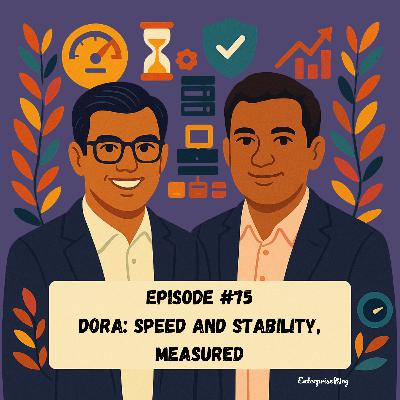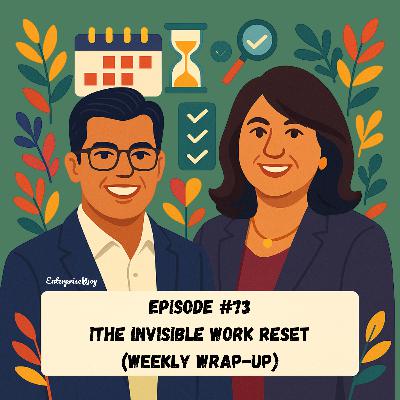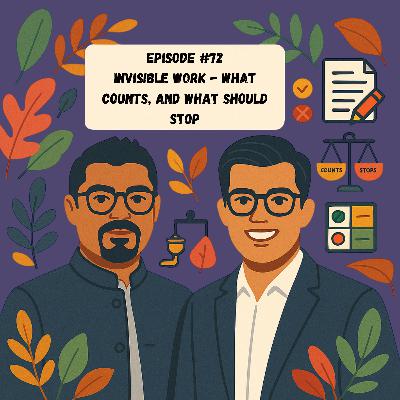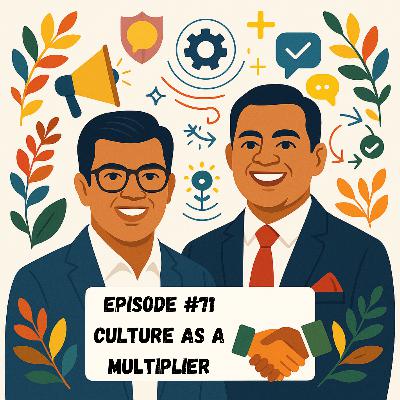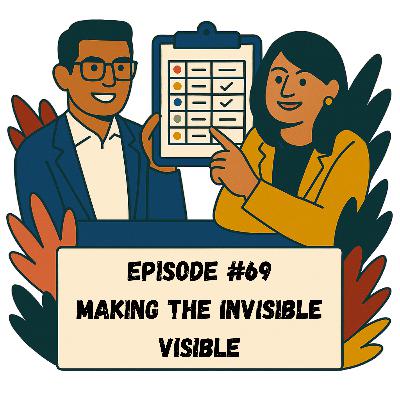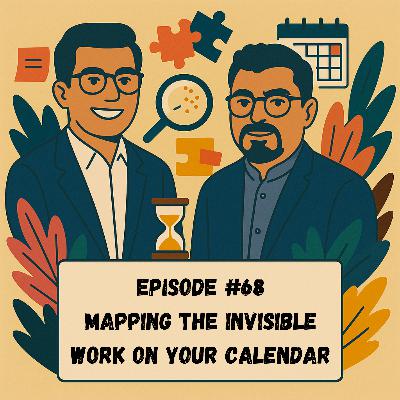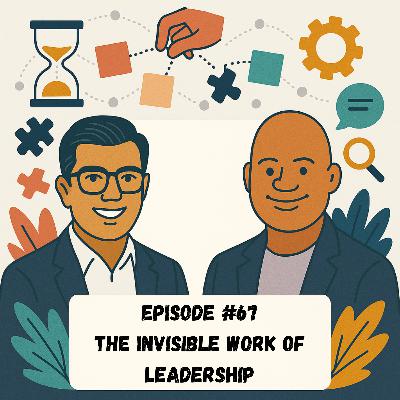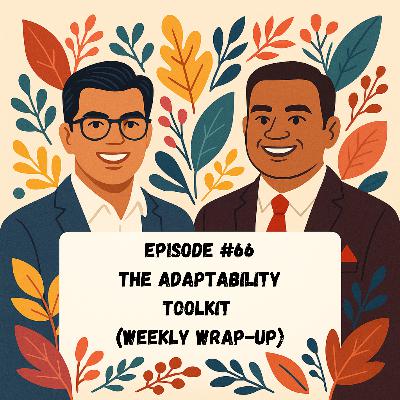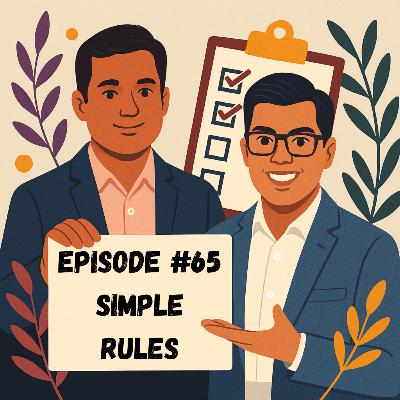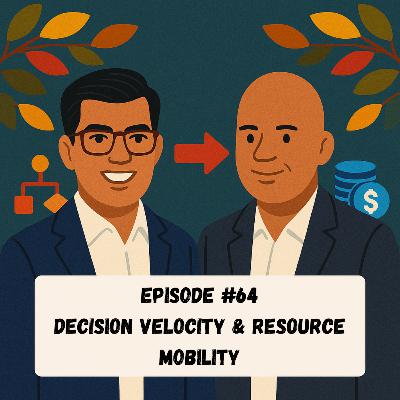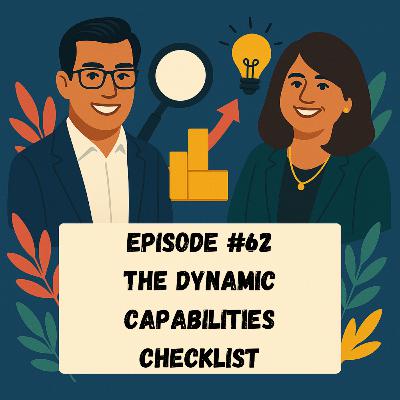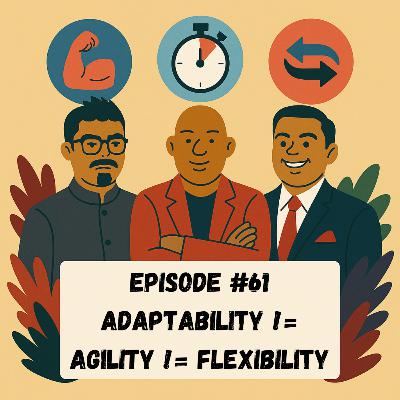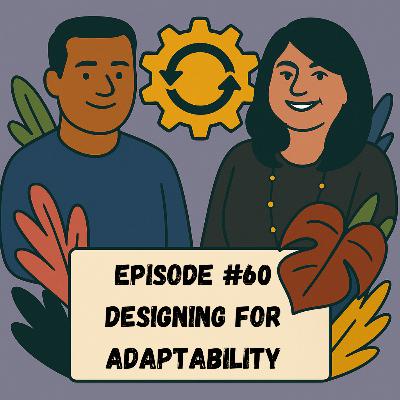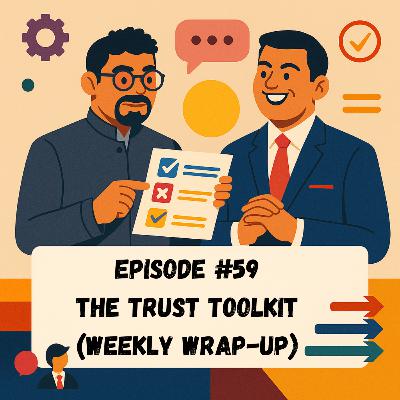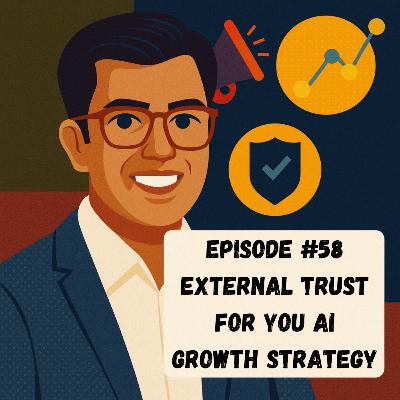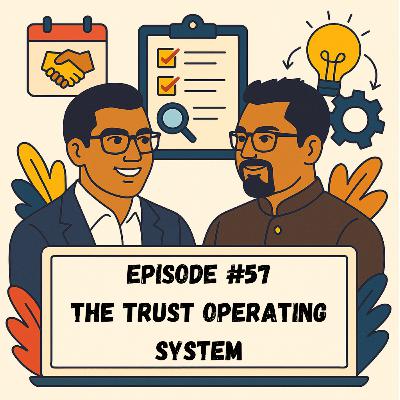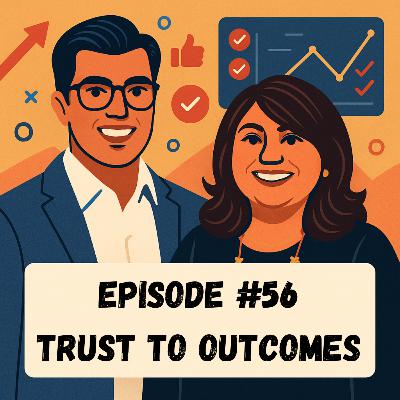Discover The EnterpriseJoy Podcast
The EnterpriseJoy Podcast

The EnterpriseJoy Podcast
Author: EnterpriseJoy
Subscribed: 2Played: 0Subscribe
Share
© 396767
Description
Hosted by Vishal Prasad, this is your daily dose of strategic clarity across HOPE - Humans, Operations, Products, and Engineering; delivered to you by the time your barista gets your coffee.
One theme per week. Seven crisp episodes. And actionable strategic insights backed by research.
No videos. No reels. Just pure podcast made for your walks, commute, breaks, or wind-down. Designed for CXOs, founders, and bold leaders who prefer momentum over meditation.
TL;DR: Enterprise Strategies for Leaders in Under 5 Minutes, because good things shouldn’t take time. That’s The EnterpriseJoy Podcast.
One theme per week. Seven crisp episodes. And actionable strategic insights backed by research.
No videos. No reels. Just pure podcast made for your walks, commute, breaks, or wind-down. Designed for CXOs, founders, and bold leaders who prefer momentum over meditation.
TL;DR: Enterprise Strategies for Leaders in Under 5 Minutes, because good things shouldn’t take time. That’s The EnterpriseJoy Podcast.
75 Episodes
Reverse
In this episode, we turn delivery data into leadership insights. We unpack what DORA actually measures, why elite performers ship faster with fewer failures, and how to wire those indicators into enterprise KPIs without trading away reliability. Expect practical moves you can brief to the board today including SLOs and error budgets, lead-time instrumentation, and decision velocity rules. Additionally, a simple actions list to baseline and improve your metrics.References:1) Accelerate State of DevOps 2021: https://cloud.google.com/resources/state-of-devops2) Accelerate: Building and Scaling High Performing Technology Organizations: https://www.goodreads.com/book/show/35747076-accelerate3) Service Level Objectives: https://sre.google/sre-book/service-level-objectives4) Implementing SLOs: https://sre.google/workbook/implementing-slos5) Embracing Risk: https://sre.google/sre-book/embracing-riskMusic Credit: Switch It Up, performed by Silent Partner, from the YouTube Studio Audio Library.
This episode takes aim at the “speed kills quality” myth with hard evidence. In five minutes we connect DORA’s data on elite performers, Little’s Law for small batches, Google SRE’s SLOs and error budgets, EnterpriseJoy’s discipline, and Netflix’s chaos engineering. You’ll see why faster feedback exposes blind spots sooner, improves stability, and raises your quality bar … because good things, shouldn’t take time.References:1) Accelerate State of DevOps 2021 (DORA): https://dora.dev/research/2021/dora-report2) Accelerate: Building and Scaling High Performing Technology Organizations: https://www.goodreads.com/book/show/35747076-accelerate3) A Proof for the Queuing Formula L = λW: https://doi.org/10.1287/opre.9.3.3834) Service Level Objectives: https://sre.google/sre-book/service-level-objectives5) Implementing SLOs: https://sre.google/workbook/implementing-slos6) Toyota Production System: https://global.toyota/en/company/vision-and-philosophy/production-system/index.html7) Chaos Engineering: https://arxiv.org/pdf/1702.058438) Chaos Engineering Upgraded: https://techblog.netflix.com/2015/09/chaos-engineering-upgraded.html9) EnterpriseJoy Philosophy: https://www.youtube.com/@EnterpriseJoyMusic Credit: Switch It Up, performed by Silent Partner, from the YouTube Studio Audio Library.
We close this week with a practical, evidence-backed reset for your calendar: the L.E.D.G.E.R. Reset. In 15–20 minutes you’ll label where your time really goes, check equity on non-promotable work, tighten decision hygiene, add guardrails for collaboration, pulse psychological safety and leader inclusiveness, and re-allocate/recognise hidden load. Anchored in CEO time-use studies, interruption research, and Andy Grove’s leverage playbook, this wrap turns invisible work into a repeatable operating system you can tune every month.Reference:1) High Output Management: https://www.goodreads.com/book/show/324750.High_Output_ManagementMusic Credit: Switch It Up, performed by Silent Partner, from the YouTube Studio Audio Library
In this episode, we separate the signal from noise in the unseen side of leadership. You’ll hear what counts and what should stop when it comes to invisible work. With clear rules you can codify today, scale what actually moves clarity, quality, and speed.References:1) 2017 Letter to Shareholders: https://www.aboutamazon.com/news/company-news/2017-letter-to-shareholders2) Decoding the DNA of the Toyota Production System: https://hbr.org/1999/09/decoding-the-dna-of-the-toyota-production-system3) American Icon: Alan Mulally and the Fight to Save Ford Motor Company: https://www.goodreads.com/book/show/13132620-american-icon4) Collaborative Overload: https://hbr.org/2016/01/collaborative-overload5) Gender Differences in Accepting and Receiving Requests for Tasks with Low Promotability: https://doi.org/10.1257/aer.201417346) Stop the Meeting Madness: https://hbr.org/2017/07/stop-the-meeting-madnessMusic Credit: Switch It Up, performed by Silent Partner, from the YouTube Studio Audio Library
In this episode, we unpack how culture becomes a force-multiplier for your systems: why teams with psychological safety learn faster and perform better, how leaders actually shape culture through Schein’s “embedding mechanisms” (what you fund, schedule, reward), and what Netflix’s “freedom & responsibility” shows about rituals that make candor travel. Expect practical moves that wire values into day-to-day execution, so your operating system runs without you pushing it uphill.References1) Making It Safe: The Effects of Leader Inclusiveness and Professional Status on Psychological Safety and Improvement Efforts in Health Care Teams: https://doi.org/10.1002/job.4132) Organizational Culture and Leadership: https://www.goodreads.com/book/show/222096.Organizational_Culture_and_Leadership3) No Rules Rules: Netflix and the Culture of Reinvention: https://www.goodreads.com/book/show/49099937-no-rules-rulesMusic Credit: Switch It Up, performed by Silent Partner, from the YouTube Studio Audio Library.
In this episode, we break down how leaders can reclaim their week from the invisible drag of coordination and decision churn by building leverage into their systems. From Amazon’s narrative memos that sharpen debate, to Bain’s RAPID framework that cuts decision ping-pong, to research on meeting-free days that protect deep work, you’ll learn three evidence-backed moves to scale your leadership without drowning in the hidden load.References:1) Why do management practices differ across firms and countries? https://doi.org/10.1257/jep.24.1.2032) How CEOs Manage Time: https://hbr.org/2018/07/how-ceos-manage-time3) Who Has the D? How Clear Decision Roles Enhance Organizational Performance: https://hbr.org/2006/01/who-has-the-d-how-clear-decision-roles-enhance-organizational-performance4) RAPID® Decision Making: https://www.bain.com/insights/rapid-decision-making/5) Site Reliability Engineering: How Google Runs Production Systems: https://research.google/pubs/site-reliability-engineering-how-google-runs-production-systems6) Stop the Meeting Madness: https://hbr.org/2017/07/stop-the-meeting-madness7) The effects of meeting-free days on autonomy, communication, and performance: https://sloanreview.mit.edu/article/the-surprising-impact-of-meeting-free-daysMusic Credit: Switch It Up, performed by Silent Partner, from the YouTube Studio Audio Library.
In this episode, we turn the “soft stuff” into usable evidence: you’ll learn a simple seven-column Leadership Ledger to track invisible work, spot who’s carrying non-promotable tasks, and link your time to outcomes. Grounded research plus Indra Nooyi’s Performance with Purpose reporting discipline, you’ll leave with a 10-minute routine to make the unseen visible and improve it week over week.References:1) CEO Behavior and Firm Performance: https://www.nber.org/papers/w232482) My Life in Full: Work, Family, and Our Future: https://www.goodreads.com/book/show/57499853-my-life-in-fullMusic Credit: Switch It Up, performed by Silent Partner, from the YouTube Studio Audio Library.
In this episode, we pull back the curtain on the six categories of invisible work and show you how to spot them in your own calendar. You’ll learn why these unseen activities matter, how uneven loads create burnout risks, and a simple four-step scan to surface where your energy is really going.References:1) Sensemaking in Organizations: https://www.goodreads.com/book/show/818257.Sensemaking_in_Organizations2) Will AI Fix Work? Work Trend Index: https://www.microsoft.com/en-us/worklab/work-trend-index/will-ai-fix-work3) Are You Taking on Too Many Non-Promotable Tasks? https://hbr.org/2022/04/are-you-taking-on-too-many-non-promotable-tasks4) Being Glue: https://www.noidea.dog/glue5) Noise: A Flaw in Human Judgment: https://www.goodreads.com/book/show/55339408-noise6) Creativity, Inc.: Overcoming the Unseen Forces That Stand in the Way of True Inspiration: https://www.goodreads.com/book/show/63934894-creativity-inc-the-expanded-editionMusic Credit: Switch It Up, performed by Silent Partner, from the YouTube Studio Audio Library.
In this episode, we dive into the hidden side of leadership, the work that never makes it to dashboards or OKRs but holds organisations together. From Karl Weick’s sensemaking to Linda Babcock’s research on non-promotable tasks, from Tanya Reilly’s “Being Glue” in engineering teams to Paul O’Neill’s safety-first turnaround at Alcoa, we explore how invisible work shapes trust, efficiency, and performance. References:1) Sensemaking in Organizations: https://www.goodreads.com/book/show/818257.Sensemaking_in_Organizations2) Will AI Fix Work? Work Trend Index: https://www.microsoft.com/en-us/worklab/work-trend-index/will-ai-fix-work3) Are You Taking on Too Many Non-Promotable Tasks? https://hbr.org/2022/04/are-you-taking-on-too-many-non-promotable-tasks4) Being Glue: https://www.noidea.dog/glue5) Alcoa’s Core Values in Practice: Paul O’Neill’s Safety Focus: https://www.hbs.edu/faculty/Pages/item.aspx?num=26838Music Credit: Switch It Up, performed by Silent Partner, from the YouTube Studio Audio Library.
In this weekly wrap-up episode, we stitch adaptability into a practical toolkit. From Monday’s distinction between flexibility, agility, and adaptability, to Tuesday’s litmus test, to Wednesday’s SLICE experimentation engine, Thursday’s levers of decision velocity and resource mobility, and Friday’s simple rules. You’ll walk away with a one-page adaptability playbook that helps you sense shifts, run disciplined experiments, move faster, free up resources, and guide decisions with clarity.References:1) Dynamic capabilities and strategic management: https://doi.org/10.1002/(SICI)1097-0266(199708)18:7<509::AID-SMJ882>3.0.CO;2-Z2) Dynamic capabilities as (workable) management systems theory: https://doi.org/10.1017/jmo.2017.753) Trustworthy online controlled experiments: A practical guide to A/B testing: https://www.cambridge.org/core/books/trustworthy-online-controlled-experiments/4) Simple Rules: How to thrive in a complex world: https://www.hmhbooks.com/shop/books/Simple-Rules/97805447052035) Heuristic decision making: https://doi.org/10.1146/annurev-psych-120709-145346Music Credit: Switch It Up, performed by Silent Partner, from the YouTube Studio Audio Library
In this episode, Vishal unpacks why simple rules are a leader’s best weapon in complex systems. Backed by research, this episode shows how three to five crisp heuristics can outperform thick manuals and guide decisions without bottlenecks. From wildfire management’s legendary LCES rule set to corporate playbooks that focus on boundaries, priorities, and timing, you’ll learn how to design rules that travel fast, scale under stress, and stick in people’s heads when leaders aren’t in the room.References:1) Simple Rules for a Complex World. Harvard Business Review: https://hbr.org/2012/09/simple-rules-for-a-complex-world2) The best rules are simple, flexible and purposeful: https://news.stanford.edu/stories/2015/04/rules-simple-eisenhardt-0429153) LCES — Lookouts, Communications, Escape Routes, Safety Zones: https://fs-prod-nwcg.s3.us-gov-west-1.amazonaws.com/s3fs-public/2023-06/lces-gleason.pdf4) Fast and frugal forecasting: https://doi.org/10.1016/j.ijforecast.2009.05.0105) Ecological Rationality: Fast-and-Frugal Heuristics for Managerial Decision Making under Uncertainty: https://doi.org/10.5465/amj.2018.0172Music Credit: Switch It Up, performed by Silent Partner, from the YouTube Studio Audio Library
In this episode, Vishal explores why adaptability fails without Decision Velocity and Resource Mobility. Backed by research and examples from Jeff Bezos and Piyush Gupta, this episode urges leaders to halve their “signal-to-decision” time and free up capital and talent for new bets. You’ll walk away with practical litmus tests and a simple one-pager to publish in your teams.References:1) DBS: Digital Transformation to Best Bank in the World: https://store.hbr.org/product/dbs-digital-transformation-to-best-bank-in-the-world/SMU816?srsltid=AfmBOopcxwtvJKsOiz8sJsmVjP3KS7DQFY6Tabz0tYRaQJE0ujCwp8Kz2) Decision-making in the age of urgency: https://www.mckinsey.com/capabilities/people-and-organizational-performance/our-insights/decision-making-in-the-age-of-urgency3) How to make the bold strategy moves that matter: https://www.mckinsey.com/capabilities/strategy-and-corporate-finance/our-insights/how-to-make-the-bold-strategy-moves-that-matterMusic Credit: Switch It Up, performed by Silent Partner, from the YouTube Studio Audio Library
In this episode, Vishal introduces SLICE (Select, Learn, Implement, Chronicle, Expand) as a practical operating system for experimentation. This episode explores how adaptability comes from a repeatable rhythm of trustworthy experiments. You’ll hear how SLICE helps leaders build experimentation into their organisation’s DNA and makes innovation a habit.References:1) SLICE - Experimentation as an Operating System: https://medium.com/@vishalprasadin/slice-b1f1e7aa2aa42) Building a Culture of Experimentation: https://hbr.org/2020/03/building-a-culture-of-experimentation3) The Discipline of Business Experimentation: https://hbr.org/2014/12/the-discipline-of-business-experimentation4) Trustworthy Online Controlled Experiments: A Practical Guide to A/B Testing: https://www.goodreads.com/book/show/51635906-trustworthy-online-controlled-experiments5) Learning from Jeff Bezos: Big winners pay for so many experiments: https://versionone.vc/learning-jeff-bezos-big-winners-pay-many-experiments/Music Credit: Switch It Up, performed by Silent Partner, from the YouTube Studio Audio Library
In this episode, Vishal unpacks adaptability through the lens of dynamic capabilities; sensing, seizing, and transforming. Drawing from strategy research and the real-world case of DBS Bank’s digital transformation, this episode breaks theory into a practical checklist: how to spot early signals before they erupt, convert them into committed bets, and rewire the organisation to sustain change. If you can answer the three checklist questions without hesitation, you’re running adaptability by design; if not, this is where you start.References:1) Explicating dynamic capabilities: the nature and microfoundations of (sustainable) enterprise performance: https://doi.org/10.1002/smj.6402) Dynamic Capabilities: What Are They? https://sms.onlinelibrary.wiley.com/doi/abs/10.1002/1097-0266%28200010/11%2921%3A10/11%3C1105%3A%3AAID-SMJ133%3E3.0.CO%3B2-E3) DBS: Digital Transformation to Best Bank in the World: https://ink.library.smu.edu.sg/cases_coll_all/309/4) Adaptability: The New Competitive Advantage: https://hbr.org/2011/07/adaptability-the-new-competitive-advantage5) McKinsey & Company (2016). How Nimble Resource Allocation Can Double Your Company’s Value: https://www.mckinsey.com/capabilities/strategy-and-corporate-finance/our-insights/how-nimble-resource-allocation-can-double-your-companys-valueMusic Credit: Switch It Up, performed by Silent Partner, from the YouTube Studio Audio Library
In Episode of The EnterpriseJoy Podcast, Vishal untangles three terms leaders often confuse; adaptability, agility, and flexibility. Drawing on research and real-world cases, he explains why flexibility is about range, agility is about pace, and adaptability is about evolution. You’ll hear how Netflix’s pivot to streaming wasn’t just agility in action, but true adaptability; a deliberate reconfiguration of its business model and culture. The episode leaves you with a practical challenge so you can stop solving the wrong problem and start leading with clarity.References:1) What Really Makes Factories Flexible? https://hbr.org/1995/07/what-really-makes-factories-flexible2) Explicating dynamic capabilities: the nature and microfoundations of (sustainable) enterprise performance: https://doi.org/10.1002/smj.6403) How Netflix Reinvented HR: https://hbr.org/2014/01/how-netflix-reinvented-hr4) Adaptability: The New Competitive Advantage: https://hbr.org/2011/07/adaptability-the-new-competitive-advantageMusic Credit: Switch It Up, performed by Silent Partner, from the YouTube Studio Audio Library
In this Sunday setup of The EnterpriseJoy Podcast, we dive into Designing for Adaptability. Vishal unpacks why adaptability is no longer a leadership buzzword but a survival toolkit, backed by decades of research showing volatility has doubled since the 1980s. You’ll hear how strategy scholars define “dynamic capabilities” and why leaders like Adobe’s Shantanu Narayen bet big on adaptability to reshape industries. Expect a week ahead filled with practical routines: from distinguishing adaptability from agility, to running experimentation as an operating system, to boosting decision velocity and crafting simple rules that travel.References:1) Explicating dynamic capabilities: the nature and microfoundations of (sustainable) enterprise performance: https://doi.org/10.1002/smj.6402) Dynamic Capabilities: What Are They? https://sms.onlinelibrary.wiley.com/doi/abs/10.1002/1097-0266%28200010/11%2921%3A10/11%3C1105%3A%3AAID-SMJ133%3E3.0.CO%3B2-E3) Adobe’s CEO on Making Big Bets on Innovation: https://hbr.org/2023/11/adobes-ceo-on-making-big-bets-on-innovationMusic Credit: Switch It Up, performed by Silent Partner, from the YouTube Studio Audio Library
In this wrap-up episode, we bring the week on trust to a close by consolidating everything measurement, behaviours, outcomes, and routines into a one-page Trust Toolkit you can carry into your Monday leadership meeting. Vishal explains how to blend metrics like the ABI model, behavioural and organisational trust inventories, and psychological safety with simple weekly habits and routines like decision logs, blameless post-mortems, and working agreements. The result? A lightweight, repeatable system that builds trust not through intensity, but through consistency.Music Credit: Switch It Up, performed by Silent Partner, from the YouTube Studio Audio Library
In this episode, we step outside the walls of the organisation and explore how external trust becomes a growth lever for AI. Using the three lenses of Assure, Explain, and Control, Vishal unpacks how frameworks from ISO and the EU AI Act are shaping the market’s expectations of risk, transparency, and governance. You’ll hear why assurances turn “trust us” into “audit us,” why transparency notes and data provenance lower adoption friction, and why serious-incident pathways build resilience before a crisis. And most importantly, how small visible artefacts move real outcomes from shorter sales cycles to higher adoption.References:1) AI Risk Management Framework (AI RMF 1.0): https://www.nist.gov/itl/ai-risk-management-framework2) ISO/IEC 23894:2023 Information technology — Artificial intelligence — Guidance on risk management: https://www.iso.org/standard/77304.html3) ISO/IEC 42001:2023 — Information technology — Artificial intelligence — Management system: https://www.iso.org/standard/81230.html4) EU Artificial Intelligence Act: https://artificialintelligenceact.eu/the-actMusic Credit: Switch It Up, performed by Silent Partner, from the YouTube Studio Audio Library
In this episode, we move from talking about trust as a value to embedding it as a system. Vishal unpacks how decision logs, blameless post-mortems, and working agreements transform trust into repeatable routines that reduces friction, increases predictability, and accelerates learning. You’ll hear why transparent artefacts signal fairness, how debriefs improve team effectiveness, and why simple, team-owned agreements outperform top-down rules. Together, these practices create a “Trust Operating System”, your shock absorbers under pressure and your reliability amplifier in the long run.References:1) Reconceptualizing organizational routines as a source of flexibility and change: https://doi.org/10.2307/35566202) Do team and individual debriefs enhance performance? A meta-analysis: https://doi.org/10.1177/00187208124483943) Failing to learn and learning to fail (intelligently): How great organizations put failure to work to innovate and improve: https://doi.org/10.1016/j.lrp.2005.04.005 4) Laying the foundation for successful team performance trajectories: The roles of team charters and performance strategies: https://doi.org/10.1037/a0013257Music Credit: Switch It Up, performed by Silent Partner, from the YouTube Studio Audio Library
In this episode, we connect trust directly to business results you can measure. Research shows that higher trust reduces turnover, strengthens engagement, and sharpens performance. You’ll hear why trust acts as an early-warning system for attrition, how fair process and transparency fuel employee commitment and innovation, and why teams with strong psychological safety outperform under pressure. We’ll also explore practical lenses for leaders, from spotting red flags in disclosure and meeting dynamics to linking trust scores with cycle time, retention, and quality on a simple Trust → Outcomes dashboard ensuring that trust becomes an operational capability.References1) Trust in leadership: Meta-analytic findings and implications for research and practice: https://doi.org/10.1037/0021-9010.87.4.6112) Trust and team performance: A meta-analysis of main effects, moderators, and covariates: https://doi.org/10.1037/apl00001103) Psychological safety: A meta-analytic review and extension: https://doi.org/10.1111/peps.121834) Authentic leadership: Development and validation of a theory-based measure: https://doi.org/10.1177/0149206307308913Music Credit: Switch It Up, performed by Silent Partner, from the YouTube Studio Audio Library


